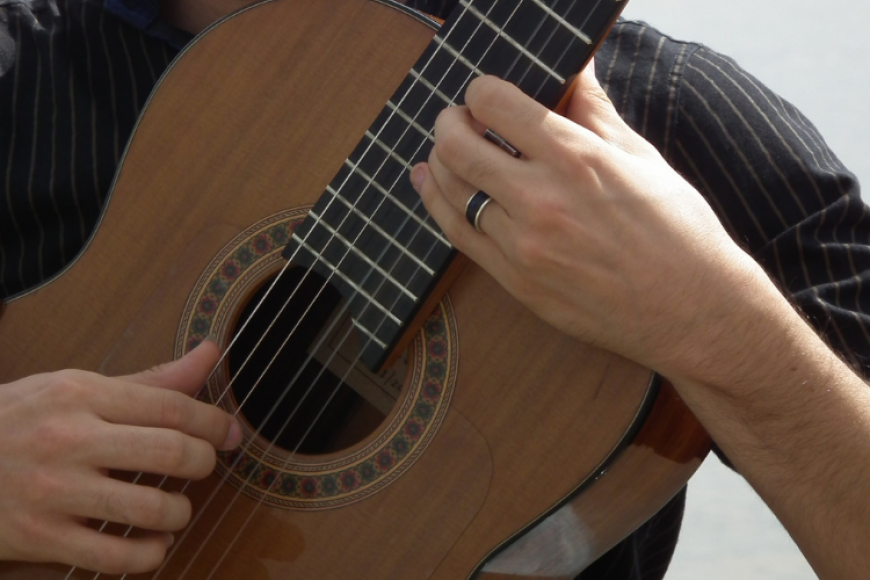Reducing Hand Tension on your Guitar Fretboard

No matter your level of experience, you've probably experienced muscular tension at some point while practicing guitar.
While tension itself is not inherently bad (and some tension is actually necessary to be able to play) the problem is that most of the time we are more tense than we actually need to be. Things like sitting in a good posture, doing some stretches, taking a few breaks during long practice sessions, doing a good warm up, and being aware of our body overall while playing are important measures to take in order to reduce some of this excess tension.
But what else can we do to feel more relaxed and enjoy more of our practice?
Pressure on the Strings
After over 15 years of studying and teaching guitar, I've found that most of the unnecessary tension we have while playing comes from the left hand pressing on the strings way too much. This excess pressure makes sense when you are first starting out, because you need to press the string down on the frets with your fingertips to get the note to sound. Pressing more than necessary however, can potentially hinder your playing by slowing you down and making articulation more difficult. That's why it's important to be aware of how much we are pressing, and to be able to “gauge” the force we exert on the strings as we press. What is the minimum pressure needed to get a good tone?
Here's a simple exercise for gaining awareness of the fingertip pressure on the fretboard. This exercise alone will produce some relaxation on the whole arm:
1. Press a string at a fret and play it.
2. Now stop pressing (but keep your fingertip in contact with the string) and play. You'll hear a muted sound.
3. Keep playing, and very gradually increase the pressure until you hear a buzz-like sound. When you hear that sound, you are on the verge of achieving the minimum pressure needed to get a tone on that fret. Now increase the pressure just barely and listen to how that buzz sound changes into a normal tone.
4. Try to notice how much you had to press to get this sound and how relaxed your arm is now. You didn't have to press very much, right?
Gravity vs. Pressure
Try imagining your arm is “hanging” from your fingertips when you are pressing a fret, instead of your fingers alone simply doing pressure against the fretboard. Feeling the weight of your whole arm can help a lot in getting your hand loose and relaxed. Doing some simple scales or chromatic exercises with this in mind is a great warm-up. Remember: you are not just using your hand and forearm muscles to press the string, you are also using your arm's weight!
Tension and Relaxation from one Hand to the Other
After doing the above described exercise with the fretboard hand, you'll find that your other hand is more relaxed as well. Tension and relaxation tend to pass from one part of the body to the other. Freeing your fretboard hand of extra tension will make your other hand more relaxed as well, creating more ease for picking, arpeggios and strumming.
Isolating Fingers in Chords
When you have to play a complicated chord or position that feels more taxing on your hand than usual, try changing the pressure you use with each finger. Try not to press at all with a finger (but remember to keep it in contact with the string) and use normal pressure with the other fingers. Then try the same with a different finger. This is a much more complex exercise, but you can do the “buzz” exercise this way in order to gain awareness of which finger is the one that's creating the most tension in that particular position.
For a better understanding of these exercises, watch the following video:
Cristóbal Schulkin Demonstrates Fretboard Exercises
| ABOUT CRISTÓBAL SCHULKIN
Hi! My name is Cristóbal, and I'm a classical guitarist from Argentina. I love cultural blends and ethnic music. Check out my vid of Koyunbaba IV on YT (it is an example of classical and ethnic music mix). I specialize in Classical Guitar but I have been into other genres as well. |
Cristóbal's lessons are rated five stars in 62 verified student reviews, like this one:
Cristobal is an excellent teacher who listens and flexes to my needs as a student. He is quick to identify improvements and does a great job to make me understand the particularities of the different musical pieces from both a technical but also an artistic perspective. He is very polite, well prepared and speaks excellent English. I am confident that with his support I will be able to improve my playing and repertoire considerably!
-Robert Neugebauer, review from April 21, 2021




